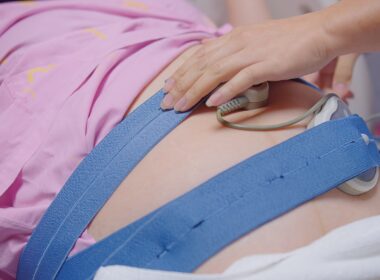While many people want to have children one day, few people actually look forward to the act of giving birth. Labor, delivery, and the postpartum period are often depicted in media as times of impossible desperation and exhaustion. There’s some truth to these depictions, as childbirth and the period that follows can be among the most difficult experiences in a woman’s life.
Perhaps for this reason, after I gave birth to my first child, I grew a renewed appreciation for chivalrous actions like holding a door open or offering a seat for a woman. I just went through hell to contribute to the perpetuation of the species, I thought. I’ll take any offers of respite!
But I have since learned that there are ways in which the childbirth and postpartum periods can be less painful. Don’t believe me? I get it; I wasn’t a believer until I experienced these myself. I can’t promise no pain, but here are three science-backed ways you can ease these most challenging times to be a woman, each of which involves embracing some of the most natural parts of womanhood that have kept the human race going for millennia.
1. Hire a doula
My first experience with childbirth wasn’t even as bad as many other women’s stories I’ve heard, but it was enough of a challenge that when it came to giving my child a sibling, I knew I needed to try something different. A friend told me she had used a doula to assist her in her hospital birth and that she found it essential to keeping her cool in delivery. It sounded like the modern woman’s version of the Red Tent—the age old tradition of women supporting women in their hour of primal need—but with medical technology readily available. I was intrigued.
After meeting a doula during my second pregnancy and hearing phrases like “it’s possible to actually enjoy childbirth,” I didn’t believe her in the slightest. But thought it couldn’t hurt to try. In the back of my mind, I held a trump card knowing that at any time I could request an epidural or other intervention if I couldn’t take the pain anymore. She was more than OK with this. But what actually happened was I received nonstop support that miraculously made each contraction’s pain manageable, which led to a significantly decreased sense of compounded pain, much less tension, a quicker delivery, and an overall more positive experience than my first. I ultimately needed no pain medication, and felt great for having lived the experience. I could hardly believe it!
As it turns out, research shows that the continual support during childbirth from doulas provide women and their babies with multiple benefits. According to a 2017 study by the World Health Organization analyzing research of more than 15,000 women across 17 countries, “continuous support during labour may improve outcomes for women and infants, including increased spontaneous vaginal birth, shorter duration of labour, and decreased caesarean birth, instrumental vaginal birth, use of any analgesia, use of regional analgesia, low five-minute Apgar score and negative feelings about childbirth experiences.” In other words, for moms who are hoping to avoid interventions like a C-section or use of instruments like forceps to remove the baby, and even excessive pain requiring analgesic medications, a doula can help them achieve those goals. Further, a 2011 study found that “the positive effects of doula care have been found to be greater for women who were socially disadvantaged, low income, unmarried, primiparous, giving birth in a hospital without a companion, or had experienced language/cultural barriers.”
It seems intuitive that to have ongoing support during labor from a woman who has been through it before could lead to a more positive experience, but it’s also great to see it reflected in empirical data. Which is why I was not surprised to learn that the Level 1 Trauma hospital where I’m planning to give birth this fall has a volunteer doula program attached to its labor and delivery services—it can augment the healthy experience for both mom and baby.
2. Breastfeed if you can
The topic of breastfeeding is fraught one for many women. While some women pursue bottle feeding for personal reasons, many women want to breastfeed but encounter difficulties that can expound their distress in the postpartum period.
A 2013 paper on the “Impact of Doulas on Healthy Birth Outcomes” found that “doula-assisted mothers were four times less likely to have a low birth weight (LBW) baby, two times less likely to experience a birth complication involving themselves or their baby, and significantly more likely to initiate breastfeeding.”
Not only does breastfeeding come with the obvious benefit of coming at no monetary cost, its health benefits for both mom and baby are well established. In addition to increasing oxytocin and helping mom and baby bond, breastfeeding can decrease chances of postpartum depression and protect babies from numerous diseases thanks to antibodies in their mothers’ milk.
In addition, breastfeeding provides a natural method of spacing children. As Cassie Moriarty explains, “The idea that breastfeeding prevents pregnancy is actually based in the sound science of how lactation affects reproductive hormones. Prolactin wants to be the dominant hormone. Nursing results in prolactin. Therefore, technically speaking breastfeeding makes your infertile. This is where the idea of the Lactational Amenorrhea Method comes from.” Natural Womanhood CEO Gerard Migeon further explains, “Lactational Amenorrhea is a complicated term to describe the connection between nursing and the continued absence of periods (and fertility). Ecological Breastfeeding and Lactational Amenorrhea Method (LAM) are particular ways of breastfeeding that are widely used to postpone a pregnancy.”
It just goes to show how nature’s way is often backed by science when it comes to helping women have a better postpartum experience.
3. Begin fertility charting if you haven’t already
Another low-cost option to ease the postpartum period that also happens to be natural and science-based is choosing a family planning method based on cycle charting, also known as Fertility Awareness-Based Methods (FABM). By learning a FABM from a trained instructor, you can learn how to read your body’s natural signs of when you are fertile and when you are not, thereby helping you avoid pregnancy based on when you have intercourse.
While it can be easier for women to learn FABM charting and read their body’s fertile signs more clearly when they are having menstrual cycles as opposed to during the postpartum period, it can still be an effective alternative for women who want to avoid having a postpartum IUD or other form of birth control that can disrupt your natural hormonal adjustment during the postpartum period. In addition, Fertility Awareness-Based Methods now benefit from the addition of technologies tailored for the postpartum period that can pinpoint ovulation using at-home testing strips, not unlike how pregnancy tests determining pregnancy hormones.
Whatever method you choose, any Fertility Awareness-Based Method of charting will prepare you for a greater sense of being in tune with your body’s natural processes, whether charting cervical fluid, basal body temperature, or hormone levels with the help of test strips. Just as the postpartum period can be a powerful time to contemplate the awesomeness of what the female body just did, it can also be a time of growing in greater understanding of it.
As I prepare now to give birth to my third child, I am thankful to know I have these three methods to ease the pain and difficulty that come with labor and the postpartum period. As I said before, I’ll take any offers of respite.
Three New Technologies to Revolutionize the Postpartum Period
Birth control after baby the natural way, technology assisted







